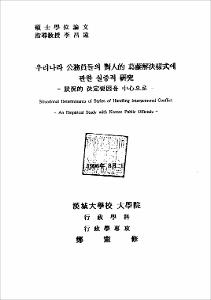우리나라 公務員들의 對人的 葛藤解決樣式에 관한 실증적 硏究
= Situational determinants of styles of handling interpersonal conflict : an empirical study with Korean public officials
- Type
- Thesis
- Alternative Title
- 狀況的 決定要因을 中心으로
- Department
- 행정학과행정학전공
- Issued Date
- 1996
- Publisher
- 漢城大學校 大學院
- Keyword
- 공무원; 갈등해결양식; 상황적 결정요인; Interpersonal conflict
- Files in This Item:
-
-
Download
 000000066331.pdf
기타 데이터 / 2.78 MB / Adobe PDF
000000066331.pdf
기타 데이터 / 2.78 MB / Adobe PDF
-
Items in Repository are protected by copyright, with all rights reserved, unless otherwise indicated.